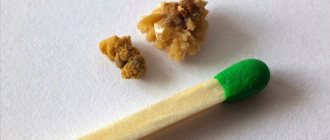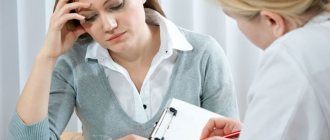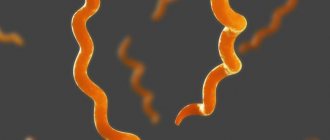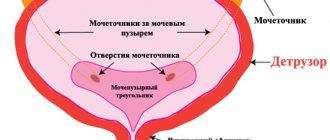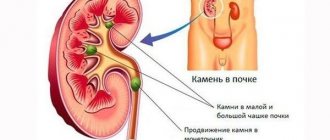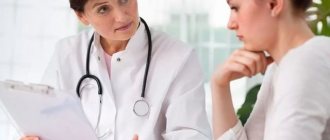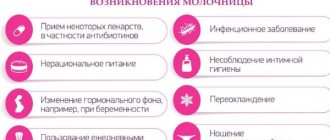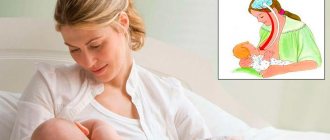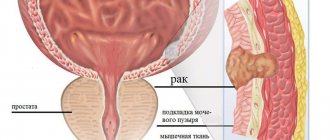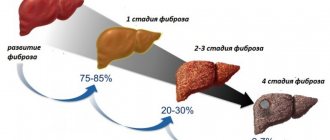What is cholecystitis
This pathology refers to gastrointestinal diseases. According to statistics, women exhibit symptoms of this pathology much more often than men. Cholecystitis usually affects adults in middle age. The gallbladder collects bile, which is synthesized by the liver. This secretion enters the duodenum through special ducts and is involved in the digestion of food.
When the sphincters and parasympathetic nervous system work correctly, bile moves in only one desired direction. Due to certain factors, the work of the sphincters becomes asynchronous, the secretion from the bladder is incompletely released, which can provoke pressure in it and cause pain. In this case, contents from the intestine can often be thrown into the ducts.
Often this content contains an infection that easily penetrates the gallbladder, causing it to become inflamed. Initially, inflammation occurs inside the organ, but later it spreads throughout the entire thickness of the bladder wall. This is how the acute form of pathology develops.
After a month or later, the walls of the gallbladder become thicker and lose their mobility. Against the background of what is happening, the outflow of bile secretions malfunctions, and the appearance of crystalline stones in the organ cannot be ruled out. Over time, the acute form of the disease can become chronic.
Symptoms
The list of signs indicating a disease depends on a huge number of factors. Symptoms of chronic cholecystitis can be both pronounced and hidden. Some patients come to the doctor with many complaints, others with only one. The main signs of chronic cholecystitis:
- Dull pain localized in the right hypochondrium. It goes to the stomach, shoulder, shoulder blade. As a rule, the stomach begins to hurt after eating something fatty, spicy, fried, or alcohol and does not subside from several hours to a day. May be accompanied by vomiting and increased body temperature.
- Acute abdominal pain after overeating.
- Mussi's cystic sign. Pain when pressing on the phrenic nerve on the right.
- Dyspeptic syndrome. Bitter taste in the mouth, unpleasant belching, coating on the tongue.
- Flatulence.
- Ortner's sign. Pain when tapping on the ribs on the right side.
- Stool disorders. Constipation may alternate with diarrhea.
Exacerbation
During the period of remission, a chronic disease may practically not manifest itself. However, there are a number of symptoms of exacerbation of cholecystitis that require immediate medical attention:
- Biliary colic. Severe pain on the right side, can be either constant or paroxysmal. After vomiting it becomes more noticeable. It subsides when a warm compress is applied.
- If there is inflammation in the peritoneum, there is an increase in pain when bending over, moving the right hand, or turning.
- Dizziness, nausea, vomiting with bile.
- Bitter belching, leaving an unpleasant taste in the mouth, dryness.
- Heartburn.
- Skin itching.
- Chills, high temperature.
- In some cases, pain in the heart area.
Causes of pathology in women
The main factor in the development of pathology is the penetration of infection into the bladder. Often this condition is caused by the following reasons:
- Inflammatory processes in the gastrointestinal tract. More often these are pathological phenomena that occur in an acute or chronic stage (for example, appendicitis, dysbacteriosis, pancreatitis, enterocolitis).
- Inflammatory diseases of the reproductive system (in women, the manifestation of signs of cholecystitis can be triggered by adnexitis).
- Viral liver damage.
- Parasitic invasion of the biliary tract.
Other factors also play a major role in the occurrence of the disease:
- dyskinesia of the bile ducts. In this case, stagnation of bile occurs, its outflow is disrupted;
- pancreatic reflux. With this pathology, intestinal contents are thrown into the ducts;
- congenital anomalies. The presence of various partitions and kinks in the organ can lead to pathology;
- disruption of the blood supply to the bladder. This disorder can be provoked by: diabetes mellitus, atherosclerosis, hypertension. The course of these diseases is characterized by a narrowing of the lumen of blood vessels;
- dyscholia is a disease in which there is a violation of the composition of bile and damage to the walls of the bladder;
- endocrine disorders;
- allergies, immunological reactions;
- overweight;
- hereditary factor.
In women, additional factors that provoke the appearance of pathology may be:
- taking oral contraceptives;
- menstrual irregularities;
- pregnancy.
Features of chronic cholecystitis
According to clinical manifestations, chronic cholecystitis is divided into two main types - acalculous (non-calculous) and calculous (stone-forming) cholecystitis, although with exacerbation of the disease it can develop in various destructive forms. According to the definition of many researchers, CBC (non-calculous, acalculous) is a collective concept that includes the genesis of an inflammatory, congenital and acquired nature.
As for the pathology in the biliary tract, the problem itself is paradoxical.
According to one version, the genesis of the metabolic state in the gallbladder (gallbladder), this is a consequence of the formation of stones, according to another, it is an inflammatory pathology. But to this day, the main question has not been clarified: is it possible to develop the inflammatory process without the influence of stone formation processes or is this process itself provoked by inflammatory reactions. Based on the principle - which came first, the egg or the chicken.
According to statistics, more than 20% of the population is affected by the disease every year. Women are affected 6 times more often than men. With age, the line of difference almost disappears, and after 50 years Chr. cholecystitis according to all post-mortem autopsies (autopsies) was found in 25% of women and only 7% of men. Such a large difference in mortality is due to untimely treatment and, in most cases, unawareness of its dangers.
The danger of chronic cholecystitis can manifest itself:
- Empyema of the gallbladder (development of purulent processes in the cavity of the gallbladder).
- Dropsy - disconnection of the gallbladder from the biliary system and filling of the cystic cavity with a large volume of inflammatory substrate.
- Phlegmon - purulent inflammation of the bladder walls.
- Necrosis and perforation of the walls of the bladder, leading to the development of subhepatic ulcers (abscess), to infectious spread to adjacent organs and peritoneum with a high risk of developing peritonitis.
- Blocking of the bile duct with a stone, mucus or pus, causing a severe form of “obstructive jaundice”.
- Development of ascending cholangitis, with infection of the intrahepatic bile ducts, causing severe liver damage or sepsis.
- Pancreatitis and pancreatic necrosis. The connection at the outlet of two outlet ducts - the Wirsungian (pancreas) and the gall bladder - greatly facilitates the entry of infection into the pancreas.
Causes of the disease and symptoms in pregnant women
Cholecystitis in pregnant women is diagnosed very often. About 3% of pregnant women suffer from bladder inflammation in the 2nd and 3rd trimester of pregnancy.
In many cases, inflammation of the gallbladder in women is a consequence of muscle contractions that control the tone of the biliary system. It all depends on progesterone, which affects smooth muscles. Because of this, there is no removal of bile secretion at the required speed, which provokes stagnation. Against this background, the infection affects the walls of the organ and triggers the inflammatory process.
Women in this position primarily feel pain, which can be localized under the rib on the right side of the body. The level of intensity of the symptom may vary, but more often pregnant women experience dull and aching pain. The symptom can increase when a pregnant woman eats spicy, fatty, fried, and salty foods.
There are a number of accompanying signs characteristic of cholecystitis present in women in position, these are:
- bouts of vomiting;
- belching;
- nausea;
- heartburn;
- bloating.
This also includes long-term toxicosis. It occurs before the 30th week of gestation, although in a healthy woman it stops no later than the 12th week.
Causes
Typically, inflammation of the gallbladder occurs due to infection of the organ by pathogenic microorganisms. All this occurs against the background of weakened immunity and the presence of underlying diseases. The hereditary factor plays a significant role in this.
The causes of inflammation are:
- infection by parasites, helminthic infestations – opisthorchiasis, giardiasis;
- hepatitis virus infection;
- entry into the gallbladder of staphylococcus and streptococcus bacteria;
- fungal infection;
- intoxication;
- prolonged exposure to allergens.
The onset of an active inflammatory process is influenced by the following factors:
- stagnation of bile due to dyskinesia or blockage of the biliary tract;
- endocrine disorders;
- acute infectious processes;
- physical inactivity, obesity;
- prolapse of the digestive tract;
- pregnancy;
- poor nutrition;
- constant consumption of alcoholic beverages, smoking;
- regular exposure to traumatic situations.
If we talk about the development of cholecystitis in children, the factors that provoke this condition may be:
- obesity due to a sedentary lifestyle;
- hereditary predisposition;
- poor immunity;
- injuries;
- developmental anomalies.
Classification of cholecystitis
Pathology, depending on the type of course, is:
- spicy _ The disease develops over several hours or days. This type of cholecystitis has pronounced symptoms. The main danger of this form of the disease is the presence of a hard formation in the gallbladder, which prevents the removal of bile secretions. A similar phenomenon can be observed in the ducts of the organ. A number of concomitant pathologies include liver damage - hepatocholecystitis, a purulent form of pericholecystitis, inflammation of the pancreatic gland. In advanced cases, the development of peritonitis cannot be ruled out, which can lead to the death of the patient;
- chronic _ In the absence of adequate treatment for the acute course of the disease, the patient may develop a chronic form of the disease. The pathology can be asymptomatic and develops gradually.
A chronic disease is characterized by division into stages:
- remission;
- exacerbation.
Chronic cholecystitis can also be divided into:
- recurrent;
- sluggish (latent);
- purulent-ulcerative.
There is a classification according to the type of inflammatory process:
- purulent;
- catarrhal;
- phlegmonous;
- gangrenous;
- mixed.
Based on the presence of stones, 2 types of cholecystitis can be distinguished:
- calculous (stone). A failure in the body's metabolic process leads to the appearance of cholelithiasis in the gallbladder - cholelithiasis occurs. Stones are formed due to a metabolic disorder; they are mixed in structure (can be crystalline, fibrous, amorphous, layered) and consist of cholesterol, bilirubin and lime. During normal functioning of the body, these substances leave the body on their own along with feces. Stones can be primary (found only in the gallbladder) or secondary (also found in the kidney ducts).
- acalculous (without cholelithiasis).
Causes
The main reason for the development of the inflammatory process in adults is the appearance of stones that interfere with the normal outflow of bile. The formation of stones can occur as a result of various diseases that affect the normal metabolic process in the body: diabetes, injury, infection.
It has been proven that this disease occurs more often in women; there are several reasons for this pattern:
- pressure on the gallbladder during pregnancy;
- the female hormone - progesterone, produced during menopause and pregnancy, negatively affects the function of the gallbladder;
- frequent diets, they lead to various digestive disorders in general.
Important! We have already written in detail about how cholecystitis manifests itself in women.
Therefore, women are more likely to experience cholecystitis. The following people are also at risk:
- people who have had various intestinal diseases and infections;
- people with parasitic diseases localized in the gastrointestinal tract, especially in the liver, gall bladder, pancreas, and intestines;
- people with cholelithiasis, especially with complications in the form of blockages, obstructions, and the formation of bedsores;
- people with diseases that interfere with the normal blood supply to the digestive system, especially in the area of the gallbladder and its walls.
These risk groups should learn more about the rules for preventing cholecystitis and other diseases of the gastrointestinal tract. Knowing about the possibility of developing possible complications will help protect against inflammation.
Cholecystitis enters the chronic stage with prolonged inflammation in the organ. Constant inflammation contributes to the compaction of the walls of the gallbladder, due to which the outflow of bile will be constantly impaired.
Important! Diseases of the gallbladder can affect the condition of the liver, the organ closest to it.
Symptoms of the disease in women
An acute attack of cholecystitis manifests itself quite clearly. The symptoms that characterize this form of the disease are:
- Sharp pain that increases after eating.
- Diarrhea.
- Vomit.
- Having a metallic or bitter taste in the mouth.
- Hyperthermia.
Symptoms of the disease in the chronic form are not so pronounced. Atrophic and sclerotic changes are present on the walls of the organ, changes occur in the chemical and physical parameters of bile.
The following symptoms may appear in women:
- constant pain in the area of the right hypochondrium, which can intensify after eating fatty foods;
- bitter taste and dry mouth in the morning;
- bloating;
- occasional nausea;
- stool disorder (loose and infrequent).
The initial sign of the presence of this pathology in the body is the presence of pain in the right side, under the ribs. Most often the pain is sharp. These sensations indicate the presence of a stone in the bile duct, which interferes with the exit of bile from the bladder, after which an inflammatory process begins to develop. The pain may disappear for a while, but then becomes permanent.
The patient's condition worsens, the temperature rises, the pulse quickens, nausea and vomiting appear. Bile does not enter the human intestines, because of this the patient’s skin and whites of the eyes turn yellow. This condition of the body is considered a precursor to jaundice. Symptoms and treatment of cholecystitis in women depend on the form and type of pathology.
An attack of chronic cholecystitis in women has symptoms similar to the acute form of the pathology. Exacerbation of chronic cholecystitis is characterized by general symptoms and local manifestations that indicate inflammation of the bladder. After the attack, all signs of the disease subside. The remission stage begins.
With a non-calculous type of pathology, the following symptoms occur:
- aching dull pain in the area of the right hypochondrium. These sensations occur more often an hour after eating or from driving on a rough road. In a sitting position, the pain intensifies, and in a lying position, the pain decreases;
- nausea and heartburn;
- cardialgic syndrome. It occurs after eating as a dull pain in the area of the heart;
- esophagic syndrome. It is associated with the presence of heartburn and the sensation of a foreign object behind the sternum. The ability to swallow is lost.
Acute cholecystitis
The cause of the pathology is a violation of bile secretion and the development of acute inflammation of the walls of the gallbladder.
What is cholecystitis
This is an inflammatory process in the gallbladder that occurs due to:
- disturbances in the outflow of bile;
- increased intravesical pressure;
- injury to the gallbladder wall with a stone;
- deterioration of blood supply to the gallbladder (in older men);
- pathogenic microflora.
The resulting condition is provoked by a violation of the patency of the biliary tract due to spasm or blockage with a stone, or atony of the gallbladder, when the organ cannot contract for the full release of bile into the duodenum. There are several forms of the pathological process:
- Catarrhal. The gallbladder increases in size, and the cavity of the organ contains mucus and accumulated bile secretions. With a mild course, men often ignore a slight deterioration in digestion and pain on the right side, postponing a visit to the doctor.
- Phlegmonous. The organ is inflamed and enlarged; the stagnant bile secretion contains pus and mucus.
- Gangrenous. Against the background of the inflammatory process, necrosis of areas of the bladder mucosa occurs.
The last form is the most dangerous. Gangrenous lesions destroy tissue and, in severe cases, can cause perforation of the wall with subsequent development of peritonitis.
Signs and symptoms
General symptoms of acute cholecystitis in men are similar to signs of poisoning. The sick person develops:
- nausea;
- unpleasant bitter taste in the mouth;
- periodic vomiting;
- acute pain in the epigastrium and under the ribs on the right;
- loss of appetite;
- bowel dysfunction;
- tachycardia;
- fever;
- general weakness.
Additional signs and symptoms of cholecystitis in men depend on the form of inflammation:
- Catarrhal course is characterized by a white coating of the tongue and increased salivation. Fever is moderate.
- Phlegmonous (purulent) cholecystitis is accompanied by moderate “grumbling” of the intestines, slight bloating, and a rise in temperature to high numbers. The pain is severe and intensifies with breathing, coughing and changing body position.
- During the gangrenous process, the abdomen is swollen, and the muscles of the anterior abdominal wall may be tense. The tongue and mucous membranes of the mouth are dry. Breathing is frequent, signs of intoxication are increasing.
Signs of cholecystitis
It doesn’t matter how severe the signs of cholecystitis are in men. Even a mild, uncomplicated course requires treatment by a gastroenterologist. Lack of timely assistance leads to the development of complications, including fatal peritonitis, and chronic disease.
Treatment of adult patients
Therapy is selected taking into account the nature of the pathology. Before prescribing treatment, a gastroenterologist analyzes the symptoms of cholecystitis in an adult man and prescribes a clinical and laboratory examination. Medicines are selected after receiving all the data and determining the form of the disease. To relieve the inflammatory process and restore organ functions, the patient may be prescribed:
- Antispasmodics (Papaverine, Drotaverine).
- Analgesics (Analgin, Baralgin). Relieves pain during an attack.
- Antibiotics. When choosing antibacterial agents, preference is given to broad-spectrum drugs (Amoxiclav, Cefotaxime).
- Cholekinetics. To eliminate stagnation of bile, use Cholisal or Xylitol.
In case of severe intoxication, the man is given infusion therapy. Hemodez, 0.9% sodium chloride solution or Ringer's solution are infused intravenously.
From the moment of exacerbation until the complete cure of acute cholecystitis, a man must follow a gentle diet.
If conservative therapy is ineffective or a life-threatening condition is identified, the patient undergoes cholecystectomy. Indications for surgery:
- gangrenous cholecystitis with large foci of necrosis;
- risk of perforation of the gallbladder wall with subsequent development of peritonitis;
- large stones that interfere with the flow of bile.
After surgical treatment, medications and dietary nutrition are prescribed.
After surgical treatment, the man is prescribed a lifelong diet to relieve post-operative symptoms. Removal of the gallbladder affects digestion and eating “heavy” foods and/or overeating causes digestive disorders: nausea and vomiting, diarrhea, abdominal pain.
Complications of cholecystitis in women
Lack of treatment for the disease can lead to the development of complications:
- formation of a fistula in the stomach;
- cholangitis;
- reactive hepatitis;
- failure of the gallbladder to perform its functions sufficiently;
- development of inflammation in the bile ducts (pericholedocheal lymphadenitis);
- perforation (blister rupture);
- intestinal obstruction;
- biliary gangrene with the development of peritonitis;
- the appearance of purulent inflammation (empyema of the bladder).
Treatment with folk remedies
Is it possible to treat cholecystitis using alternative medicine methods? Folk remedies are good at preventing inflammation of the gallbladder and its ducts, reducing the risk of stone formation, and avoiding relapses of the disease at home. But they should be considered only as an auxiliary method of therapy. You should first consult with your doctor.
The following recipes are used in the treatment of cholecystitis:
- Wash, peel and finely grate medium-sized beets, fill the mixture with water, the liquid should be 3-4 cm above the chopped vegetable. Boil the mixture over low heat until a homogeneous puree is obtained, consume 50 g before each meal.
- Drink 50 ml of juice from ripe rowan berries every day during the season.
- Mix 200 ml of black radish, carrot, beet, lemon and horseradish juice, add 125 ml of alcohol. Keep the mixture in a dark place for 10 days, take 15 ml before meals three times a day.
- Wash and dry 30 leaves of bay laurel, grind into powder, pour in 200 ml of unrefined sunflower oil, leave for a week, filter. Add 15 drops of medicine to tea, milk or kefir three times a day.
- In case of exacerbation of cholecystitis, it is necessary to prepare a mixture of 150 ml of olive oil, 50 ml of menthol, 100 ml of cognac. Drink 15 ml per day, first you need to apply a warm compress to the area of the right hypochondrium.
Important! Cabbage juice helps well with cholecystitis - you need to drink it warm, 100 ml every day before meals. If an ultrasound reveals stones in the gall bladder, you should not take choleretic drugs!
First aid for an attack
If an attack of cholecystitis occurs, you should call an ambulance.
The patient is advised to take a lying position and put ice on the stomach. In case of unbearable pain, take an antispasmodic - “No-shpa” or “Papaverine”; to relieve nausea, it is recommended to drink still mineral water or mint tea. If the patient vomits, it is necessary to collect the vomit for analysis.
Treatment
Drug therapy for cholecystitis is aimed at combating infection, bile stasis, spastic and pain syndromes.
- Antibiotics that easily penetrate bile are prescribed: Levomycetin, Ciprofloxacin, Erythromycin, Doxycycline and Ampiox.
- Antibiotic therapy is promptly adjusted in accordance with the results of bile cultures for pathogenic microflora and sensitivity to ABT.
- Identification of microflora insensitive to ABT requires treatment with Biseptol and Bactrim or Furazolidone and Furadonin, which suppress the entire spectrum of pathogenic flora, including Giardia.
- Spasms are relieved with the help of the direct action of antispasmodics (Drotaverine, Papaverine) and M-anticholinergic agents (Metacin and Platiphylline). Prescribing potassium and sodium channel blockers, for example, Dicetel or Duspatalin, avoids systemic side effects - hypotension and weakness. The appointment of Odeston also allows you to influence only the muscles of the biliary tract.
- In case of hypodynamic disturbances in the motility of the ducts and bladder, prokinetics are prescribed (Motonium or Motilium, Metoclopramide or Motilak).
- If an exacerbation or attack is accompanied by symptoms of intoxication, detoxification measures are carried out.
- For calculous cholecystitis, litholytic drugs are used - chenodeoxycholic and ursodeoxycholic acids.
- Choleretic, choleretic and cholekinetic drugs (Allohol or Holagol and Olimethin or Odeston) are prescribed outside of exacerbations of non-calculous uncomplicated cholecystitis.
The doctor must decide what to treat, monitor the treatment process, and determine what to do during attacks of cholestasis after examining and thoroughly examining the patient; self-medication is unsafe.
Diagnosis of pathology
To make a diagnosis, the doctor examines the patient, learns about the symptoms and palpates the patient's abdomen. When examining the oral cavity, a coated tongue is visible, which indicates congestion in the gallbladder. There is pain when palpating the abdomen.
To diagnose this pathology, the doctor can use the provocation method to cause unpleasant sensations - he performs minor blows and touches in the area of the right lower rib, which causes pain in the patient with cholecystitis. This reaction of the body is called Ortner's symptom.
Palpation of the sternocleidomastoid muscle and touching the patient's neck area under the ear with fingers can also cause pain in patients with cholecystitis, this is called the Mussi-Georgievsky symptom. The doctor also prescribes the following laboratory and instrumental studies:
- Ultrasound.
- CT.
- MRI.
- X-ray.
- Blood test, blood biochemistry.
- Coprogram.
- Esophagogastroduodenoscopy. During this study, a biopsy is performed.
- Cholecystoangiography.
- Hepatobiliary scintigraphy.
Diagnostics
The doctor knows what calculous cholecystitis is and how to treat the disease. To establish the final diagnosis of “calculous cholecystitis”, a whole range of diagnostic measures is required. These include:
- studying the patient’s medical history and life history;
- performing a thorough questioning and physical examination;
- liver tests;
- clinical and biochemical blood test;
- general and biochemical examination of urine;
- microscopic examination of stool;
- Ultrasound of the affected organ;
- cholecystography;
- RCP;
- percutaneous transhepatic cholangiography;
- cholescintigraphy;
- scintigraphy of the hepatobiliary system.
RCP procedure
Treatment of cholecystitis in women
Treatment methods for women depend entirely on the manifestations of the symptoms of the pathology. Treatment of chronic pathology in the remission phase differs from treatment of the disease during exacerbation. There are two ways to treat this disease: conservative and surgical.
When a patient has an attack of the disease, treatment is aimed at getting rid of symptoms and stopping the pathogenetic reactions of the pathology. In the remission phase, therapy is aimed at preventing relapses.
Drug therapy for chronic cholecystitis in the acute phase is based on the use of the following medications:
- choleretic drugs: “Nicodin”, “Allohol”, “Sorbitol”, “Cyqualon”.
- drugs that stimulate peristalsis: Domperidone.
- antibiotics: Furazolidone, Oxacillin. "Erythromycin", "Doxycycline", "Biseptol", "Ciprofloxacin", "Metronidazole".
- antispasmodics: “Platifillin”, “Pitofenone”, “Papaverine”, “Drotaverine”.
- antiemetics: “Diprazin”, “Cerucal”.
- NSAIDs: Spazgan, Baralgin.
- multienzyme drugs: “Pancreatin”, “Festal”.
- sedatives: tincture of motherwort, valerian.
In the fight against chronic cholecystitis, a procedure such as tubeless tubing is used. The technique involves washing the ducts to stimulate the process of bile secretion.
You can use physiotherapy: electrophoresis with Novocaine, inductothermy, balneotherapy.
When a patient is diagnosed with calculous pathology, a planned cholecystectomy is prescribed - an operation to remove the gallbladder.
For pregnant women, surgical intervention is not indicated. Natural choleretic drugs applicable in such cases may be prescribed. In rare cases, with cholecystitis, a doctor prescribes antibiotics to a pregnant woman.
Traditional methods of treatment
To maintain the health of a patient with cholecystitis, you can add some traditional medicine recipes to the main treatment. Be sure to consult with your doctor before doing this.
For cholecystitis, it is good to drink beetroot, cucumber, and lemon juice. Infusions based on buckthorn, peppermint, and dandelion have proven themselves well.
Traditional methods
In addition to diet, treatment with folk remedies is possible.
One of the effective methods of treatment is a decoction of horseradish root. It must be grated and filled with water, which should be 4 times more than the mass itself.
It is important to close the resulting water in a container and put it in the refrigerator for at least a day, after which it can be heated, filtered and drunk before meals.
To relieve pain, you need to make a decoction of plantain and chamomile. It is better to chop the plantain leaves and combine with chamomile in equal quantities, then put on low heat and cover with a lid. The broth should boil for 5 minutes, then set aside from the stove and let it brew for a couple of hours. When pain appears in the stomach and liver, the decoction should be slightly heated and consumed undiluted, half a glass.
A remedy suitable for everyone is oatmeal or flakes. It will be very effective for chronic cholecystitis. You can make tinctures and decoctions from it. Oatmeal is poured with boiling water in large quantities and left for a couple of hours. The liquid with beneficial minerals and enveloping properties should be drunk several times a day, and especially before bed.
Another useful and tasty method of cooking is using milk. First, oatmeal is mixed with water and jelly is made from it. Milk is poured into the resulting mass and placed on the fire for a few minutes. You can take this tincture with honey, which will also be beneficial for the immune system.
